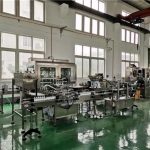You Must Know About Filling Nozzles
Filling nozzles, sometimes called filling needles or filling tubes, are the discharge pointof the filler, where product enters the container.
In general nozzles should be as large a diameter as possible while still being smallenough for the container opening. Larger diameter means lower product velocity for agiven flow rate. This reduces foaming, splashing and agitation caused by high flowrates. On the other hand, the nozzle must be small enough that it allows air to escapefrom the container during filling. The annular opening between nozzle and container will impact the velocity of the escaping air. If filling above or just inside the containeropening, this escaping air can sometimes have enough velocity to blow the product outas it tries to enter the container.
Nozzle diameter will also be affected by product viscosity and consistency. A moreviscous product will require a larger diameter to achieve a satisfactory flow rate andavoid excessive pumping pressure

Nozzles are an important component to liquid filling machines, However, they’re often overlooked when searching for the right liquid filling solution for your production needs. They are a critical element to the success of your liquid filling – designed to control the direction of fluid flow, making for accurate fills day-after-day.
There are a large variety of nozzle offerings. Today, will be breaking down the variety of nozzles and what to be aware of when deciding what works best for your liquid filling application.
- 1. Straight-Through Nozzles
- Straight-Through Nozzles, or open nozzles, are the most common and all-purpose nozzles you will see on most liquid filling machines in use. As the name suggests, an open nozzle is well… open, with nothing stopping fluid flow. Of course, these nozzles still help guide liquid products into containers.
- 2.Ball-Check Nozzles
- Ball-Check Nozzles are designed with a ball at the top of the nozzle and are spring-assisted. When a liquid is going through the Ball-Check Nozzle pressure pushes the ball up so liquid can pass-through. When it stops, the ball comes back down and closes the nozzle passageway.
- Depending on your application, Ball-Check Valve Nozzles or Straight-Through (Open) Nozzles will cover most production needs. It is a simple design and helps reduce dripping and control product. A screen can be added to the tip of the nozzle to control dripping and reduce foaming.
- 3. Valve-In-Tip Nozzles
- Valve-In-Tip Nozzles feature a tip at the end of the nozzle that opens and closes. This is known as a positive shutoff and is considered a “non-drip nozzle”. The shutoff occurs at either the end-of-the-nozzle or the top.
- Typically, Valve-In-Tip Nozzles are used when dripping or stringing is an issue when filling. A liquid with a higher centipoise (viscosity) rating such as honey, creams, gels, lotions and hot filled products such as deodorant.
- 4. Purge Nozzles
- Purge Nozzles are used when a customer has an application where they need to purge the container that is going to be filled. Gasses, typically nitrogen, are used pre or post filling. A Purge Nozzle is essentially a nozzle within another nozzle. The inner nozzle fills the product into the container. The outer nozzle will send pressurized gas around the inner nozzle to purge the container.
- Purge Nozzles are needed when a customer wants to eliminate air in the container, after it is capped or sealed. Nitrogen is a heavier gas than air, so if you put it in after air it will stay there until you put the cap on. If you use nitrogen pre-filling, it displaces air from the container.
- Purge Nozzles are most often used in pharma and biotech filling applications and products that are sensitive to oxygen or air. If air is present there could be deterioration of the liquid product.
- 5. Nozzle Size
- Nozzles come in a wide variety of different diameters and lengths. Typically nozzles are 3 – 12 inches long and the diameters up to 1 inch.
- The nozzle size really comes down to type of product being filled, speed and rate of filling, type of container, size of the opening, etc.
If you have additional questions on nozzle configurations, or what may work best for your filling application, please contact us.We would be happy to help.

 Previous Post
Previous Post Next Post
Next Post